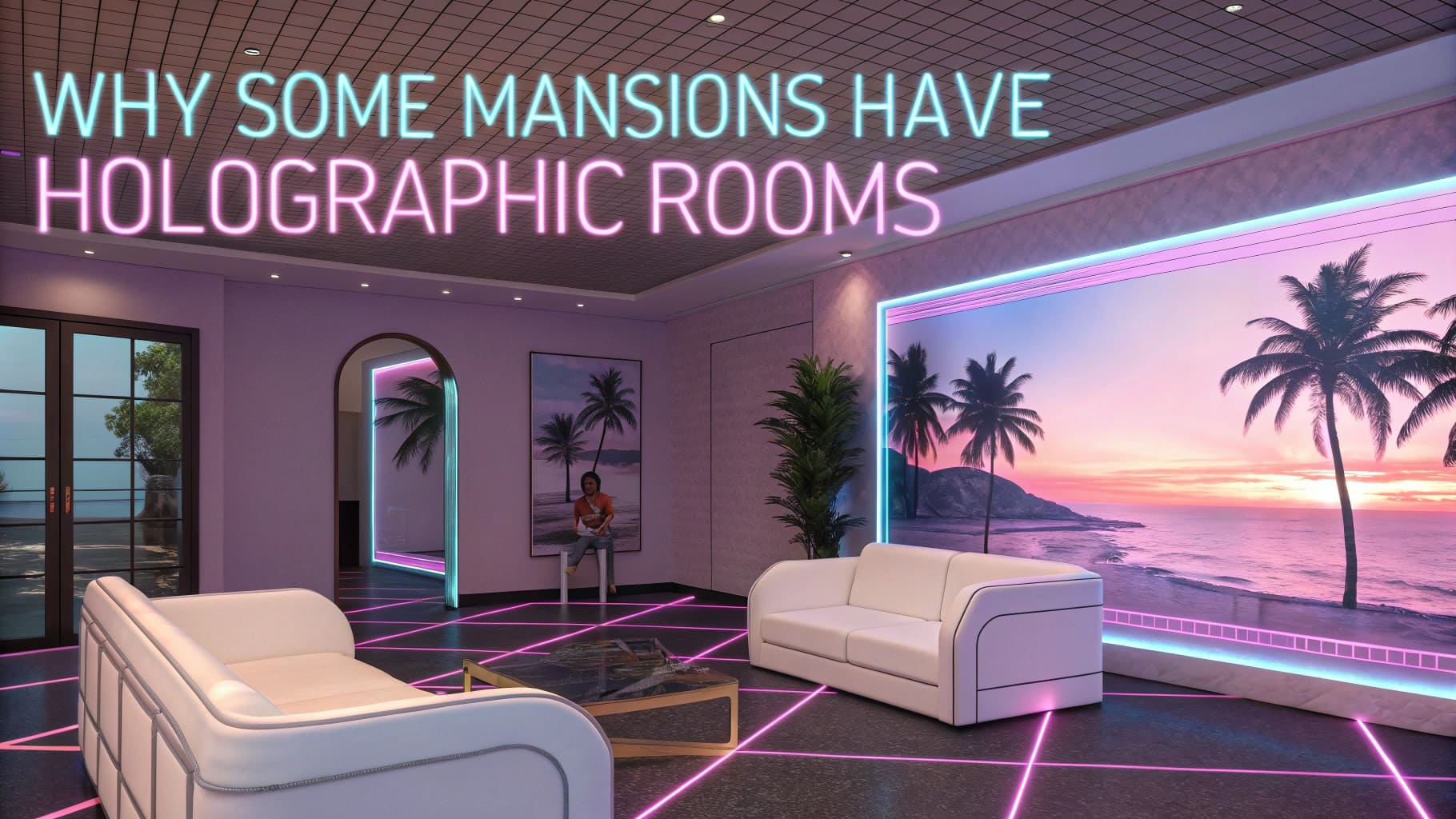In recent years, the integration of holographic technology into mansion design has gained significant traction, marking a transformative shift in how luxury residences are conceptualized and experienced. This evolution is driven by advancements in display technology, computing power, and a growing consumer appetite for unique, immersive environments. Holography, which allows for the projection of three-dimensional images that can be viewed from multiple angles without the need for special glasses, has emerged as a cutting-edge tool for architects and designers.
This technology not only enhances aesthetic appeal but also redefines spatial dynamics within luxurious homes. The rise of holographic technology in mansion design is also a response to the increasing demand for personalization and bespoke living experiences. Homeowners are no longer satisfied with traditional layouts and decor; they seek environments that reflect their individuality and lifestyle.
Holographic displays can be customized to showcase art, landscapes, or even interactive elements that engage residents and guests alike. This capability allows for a fluidity in design that was previously unattainable, enabling spaces to transform according to mood, occasion, or personal preference. As a result, the incorporation of holographic elements is becoming synonymous with modern luxury, setting new standards in high-end real estate.
Creating a Unique and Immersive Experience for Residents and Guests
Immersive Escapes
For instance, a living room could be transformed into a serene beach scene with the gentle sound of waves and the visual splendor of a sunset, providing an escape from the hustle and bustle of everyday life.
Enhanced Experiences
This level of immersion fosters a deeper emotional connection to the space, enhancing the overall quality of living. Moreover, the interactive nature of holographic displays allows for engaging experiences that can be tailored to specific events or gatherings.
Interactive Entertainment
Imagine hosting a dinner party where the dining area is adorned with holographic projections of exquisite table settings or seasonal themes that change throughout the evening. Guests can interact with these projections, perhaps selecting different themes or visual elements via a simple gesture or voice command. This interactivity not only entertains but also encourages social engagement, making gatherings more memorable and unique.
Holographic Rooms as a Status Symbol in Luxury Real Estate
In the realm of luxury real estate, status symbols have evolved beyond traditional markers such as square footage or opulent materials. Holographic rooms have emerged as a new benchmark for exclusivity and sophistication. The mere presence of such advanced technology within a mansion signals to potential buyers that they are investing in a property that embodies innovation and modernity.
This trend is particularly appealing to affluent individuals who value cutting-edge technology as part of their lifestyle. The appeal of holographic rooms extends beyond their novelty; they represent a commitment to embracing the future of living spaces. High-net-worth individuals are increasingly drawn to properties that offer unique features that set them apart from conventional homes.
A mansion with dedicated holographic rooms not only enhances its marketability but also positions it as a forward-thinking investment. As more luxury developments incorporate this technology, it is likely to become a standard expectation among discerning buyers, further solidifying its status as a hallmark of elite living.
The Practical Applications of Holographic Rooms in Mansion Living
While the aesthetic and experiential aspects of holographic rooms are often highlighted, their practical applications cannot be overlooked. These spaces can serve multiple functions, adapting to the needs of residents throughout the day. For example, a holographic room can function as a home office during work hours, projecting virtual screens and interactive tools that facilitate productivity.
As the day transitions into evening, the same space can morph into an entertainment hub, showcasing movies or immersive gaming experiences that engage family and friends. Additionally, holographic technology can enhance wellness and relaxation within mansion living. Homeowners can create calming environments for meditation or yoga sessions by projecting tranquil landscapes or guided visualizations that promote mindfulness.
The versatility of holographic rooms allows for seamless transitions between work, leisure, and self-care, making them invaluable assets in modern luxury homes. This adaptability not only maximizes the utility of space but also enriches the overall living experience.
How Holographic Rooms Enhance Entertainment and Leisure in Mansions
Entertainment is a cornerstone of mansion living, and holographic rooms elevate this aspect to unprecedented heights. With the ability to project high-definition visuals and create immersive soundscapes, these spaces transform traditional entertainment experiences into multi-sensory events. For instance, movie nights can be reimagined with holographic projections that bring characters to life in three-dimensional form, enveloping viewers in the narrative like never before.
Moreover, holographic rooms can facilitate interactive gaming experiences that engage multiple players simultaneously. Imagine hosting friends for an evening of virtual reality gaming where holograms create lifelike avatars and environments that respond to players’ movements. This level of interactivity not only enhances enjoyment but also fosters camaraderie among guests, making entertainment an integral part of social gatherings in luxury homes.
The potential for customization further amplifies this experience; homeowners can curate unique themes or scenarios tailored to their guests’ preferences.
The Integration of Holographic Technology with Smart Home Features
The integration of holographic technology with smart home features represents a significant advancement in mansion design. As smart home systems become increasingly sophisticated, combining them with holography creates an ecosystem where technology enhances daily living seamlessly. Homeowners can control lighting, temperature, security systems, and entertainment options through intuitive interfaces that incorporate holographic displays.
For example, residents could use voice commands or gestures to adjust their home’s ambiance while simultaneously projecting visual elements that complement their desired atmosphere. A simple command could transform a room from a bright workspace into a cozy retreat with soft lighting and soothing visuals projected on the walls. This synergy between smart home features and holography not only simplifies daily tasks but also enriches the overall living experience by creating environments that respond dynamically to individual needs.
The Future of Holographic Rooms in Mansion Design and Construction
Looking ahead, the future of holographic rooms in mansion design and construction appears promising as technology continues to evolve at an unprecedented pace. Innovations in materials science and display technology will likely lead to even more sophisticated holographic systems that are more accessible and affordable for luxury homeowners. As these advancements unfold, we may see holography integrated into various aspects of architectural design beyond dedicated rooms—such as walls that can transform into interactive displays or ceilings that project immersive night skies.
Furthermore, as sustainability becomes an increasingly important consideration in luxury real estate development, holographic technology may offer eco-friendly alternatives to traditional decor and art installations. By utilizing digital projections instead of physical materials, homeowners can reduce their environmental footprint while still enjoying visually stunning environments. This intersection of technology and sustainability will likely shape the future landscape of mansion design, appealing to environmentally conscious buyers who seek both luxury and responsibility.
Considerations for Implementing Holographic Rooms in Existing Mansions
Implementing holographic rooms in existing mansions presents unique challenges and considerations that must be addressed to ensure successful integration. One primary concern is the structural feasibility of retrofitting spaces to accommodate advanced holographic systems. Existing layouts may require significant modifications to optimize lighting conditions and spatial configurations for effective projection.
Collaborating with architects and designers who specialize in holographic technology is essential to navigate these complexities. Additionally, homeowners must consider the technological infrastructure required to support holographic systems effectively. High-quality projectors, sound systems, and interactive interfaces necessitate careful planning regarding wiring and connectivity throughout the mansion.
Ensuring compatibility with existing smart home systems is also crucial for creating a cohesive technological environment. By addressing these considerations thoughtfully, homeowners can successfully incorporate holographic rooms into their residences, enhancing both functionality and aesthetic appeal while embracing the future of luxury living.
If you’re interested in futuristic home technology like holographic rooms, you may also want to check out this article on smart plugs going offline. This piece discusses the challenges and solutions for maintaining a smart home setup. It’s fascinating to see how technology is transforming our living spaces and making them more interactive and convenient.
FAQs
What are holographic rooms in mansions?
Holographic rooms in mansions are rooms that use holographic technology to create immersive and interactive experiences for the occupants. These rooms can display holographic images, videos, and interactive elements to enhance the overall ambiance and functionality of the space.
How do holographic rooms work?
Holographic rooms typically use a combination of projectors, sensors, and specialized software to create and display holographic images. The projectors emit light onto a specialized surface, creating the illusion of three-dimensional holographic objects and scenes. Sensors track the movements of the occupants, allowing for interactive experiences within the holographic environment.
What are the benefits of having holographic rooms in mansions?
Holographic rooms can provide a unique and futuristic entertainment experience for the occupants of the mansion. They can be used for immersive gaming, virtual tours of exotic locations, interactive art displays, and more. Additionally, holographic rooms can add a high-tech and luxurious element to the overall design of the mansion.
Are holographic rooms in mansions expensive to install and maintain?
Yes, holographic rooms in mansions can be expensive to install and maintain. The technology required for holographic rooms, including projectors, sensors, and specialized software, can be costly. Additionally, regular maintenance and updates may be necessary to ensure the holographic system continues to function properly.
Are holographic rooms becoming more common in luxury homes?
While holographic rooms are still relatively rare, they are becoming more common in luxury homes and mansions as technology advances and becomes more accessible. As the demand for high-tech and immersive experiences grows, it is likely that holographic rooms will become more prevalent in luxury real estate.

